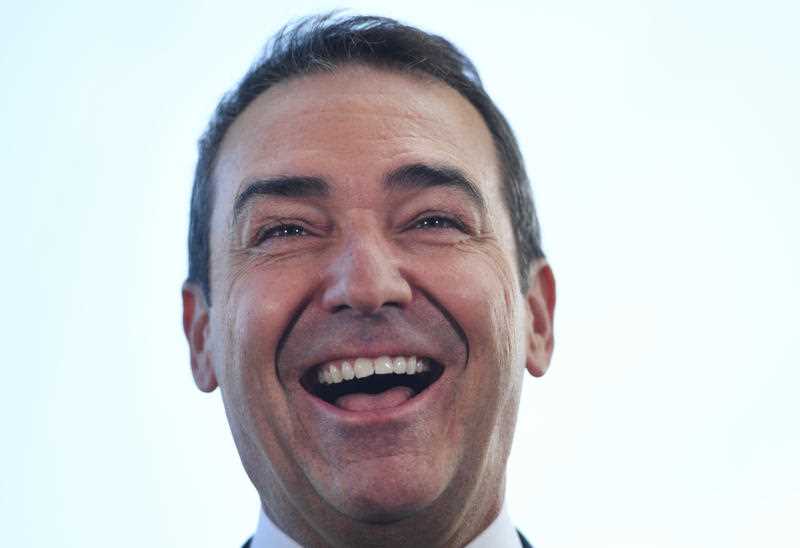Newly elected South Australia premier Steven Marshall is discovering it is not an easy switch between political rhetoric and actual policy – particularly in energy.
Marshall’s comments on Monday – just minutes before his swearing in – that the Tesla virtual power plant, the biggest planned aggregated installation of solar and battery storage in the world, was not part of his agenda has touched a raw nerve.
It was the focus of his first press conference after his swearing in, sparked questions on ABC’s Q&A, and provoked such interest and outrage on RenewEconomy’s platform, and social media, that Marshall’s team had no choice but to take note.
Look at this response on Facebook.
It reached more than 150,000 people. (RenewEconomy’s post did similar numbers), which is more than 10 per cent of the voting population in South Australia. Their reaction?
Love: 0.5%
Ha Ha: 1%
Wow: 11%
Sad: 15%
Angry: 73%
Already, it has prompted Marshall’s team to reassure the community that no contracts written by the previous Labor government would be broken.
This (as we wrote on Monday) at least guarantees the future of the first two stages of this Tesla virtual power plant project (1,100 out of 50,000 homes) and softens concerns for other projects like the Snowtown solar and storage project, and the huge renewable hydrogen hubs.
(Marshall’s advisors were also on the phone to RE – not to contest the story, but to say hi, we do get it, and that we should watch this space. Trust us, we are).
Marshall’s comments to the ABC on Monday were instinctive. For years he has been programmed to say that whatever Labor suggested must be bad, just like the 75 per cent renewable energy target.
But his team, and Marshall should now learn, the campaign is over. And like that 75 per cent renewables target, and the 25 per cent renewables storage target that went with it, the Tesla big battery is something that could, and should, happen anyway.
Just think about it. The initial contract to provide a mere $2 million grant, and a $30 million loan, costs the government little, and will initiate the rollout of 5kW rooftop solar systems and 13.5kWh Powerwall 2 battery system into 1,100 homes, and then be expanded to 50,000 at no further cost to the government.
One of the beauties of the scheme is that the idea is to attract private investment, and more importantly a new retailer to a market in desperate need of more competition. That can only be done in a political environment that is not hostile to such initiatives, because investors want certainty.
The Tesla plan has multiple other benefits too. The aggregated nature of a “virtual power plant” means that the 250MW capacity, and 650MWh of storage from those 50,000 homes can be harnessed to provide grid services, and to provide an extra resource if supplies get tight.
But it will also reduce demand from the grid – a benefit for any network seeing increasing growth in renewables – and providing a facility to store much of the output rather than having it flood back into the market when it is not needed.
And it will lower prices – not just for those who need it most, the low income households that are the targeted beneficiaries of this scheme and who have hitherto been largely left out of this transition – but to all energy users.
And there is nothing to stop Marshall going ahead with his own party’s plans for a government subsidy targeted at 40,000 middle income households that already have rooftop solar.
The offer of a grant of $2,500 means that it will only likely be taken up by those with the cash, or access to borrowing, to pay for the balance, or to install rooftop solar if the do not have it already.
And that would be a signature achievement.
In four years time, you can imagine South Australia with more than 90,000 homes with both solar and storage – from the Tesla plan, the Liberals plan and even the AGL virtual power plant, now using Tesla and LG Chem for its 1,000 household rollout.
It would address one of the biggest challenges for the operators of the grid – rooftop solar in South Australia is expected to grow so quickly, that by 2025 the output of rooftop solar would exceed the state’s minimum grid demand.
With these plans, the problems are solved.
We expect that Marshall’ team, and the team to be put together by new energy minister Dan van Holst Pellekaan, will be getting this message from market operators, grid operators, the battery storage developers like Tesla, and the software providers urging them to link their subsidy plan so it, too, can be a virtual power plant.
So once the new government is settled into its role, common sense will prevail, political battles buried, and a way found forward. It would be quite stunning if they weren’t.








